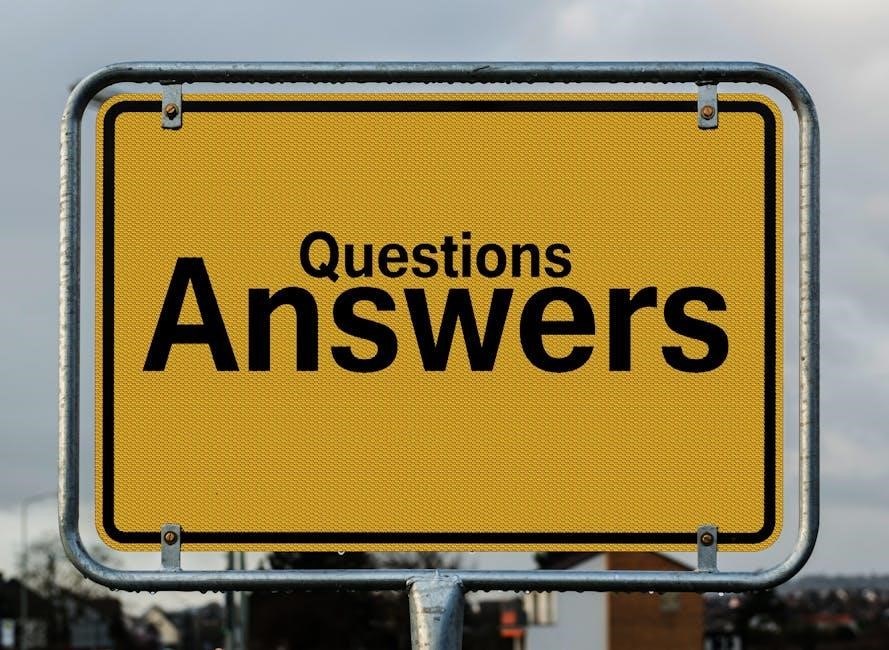What Are Guiding Questions?
Guiding questions are clear‚ focused inquiries designed to direct thinking‚ exploration‚ and learning. They help individuals or groups focus their investigations and encourage critical thinking and analysis.
Definition and Overview
Guiding questions are carefully crafted inquiries designed to steer exploration‚ learning‚ and critical thinking. They provide clear direction‚ helping individuals or groups focus on specific objectives or topics. These questions are typically open-ended‚ encouraging deeper analysis and the exploration of multiple perspectives. By framing discussions or investigations‚ guiding questions ensure that efforts remain purposeful and aligned with desired outcomes. They are essential tools in education‚ research‚ and decision-making‚ fostering engagement and understanding in various contexts.
Purpose of Guiding Questions
Guiding questions serve to focus investigations‚ spark curiosity‚ and promote deeper understanding. They help individuals or groups concentrate on key issues‚ explore ideas systematically‚ and stay aligned with objectives; These questions encourage critical thinking‚ analysis‚ and problem-solving by prompting users to examine assumptions‚ evaluate evidence‚ and consider diverse perspectives. In educational and professional contexts‚ guiding questions facilitate meaningful discussions‚ decision-making‚ and learning outcomes. They act as tools to clarify goals‚ prioritize efforts‚ and ensure that inquiries remain relevant and productive.
Importance in Research and Learning
Guiding questions play a crucial role in research and learning by providing structure and direction. They help clarify objectives‚ ensuring investigations remain focused and relevant. By fostering critical thinking and encouraging the exploration of multiple perspectives‚ these questions enhance comprehension and analytical skills. They also promote collaboration and effective communication among participants. Guiding questions prevent research from becoming overly broad or tangential‚ allowing for deeper insights and more organized findings. This structured approach significantly enhances the efficiency and quality of both individual and group learning experiences.

Key Characteristics of Guiding Questions
Guiding questions are clear‚ specific‚ and relevant‚ ensuring focus and direction in inquiry. They promote critical thinking‚ exploration‚ and deeper understanding while maintaining alignment with learning objectives.
Clarity and Specificity
Clarity and specificity are essential for effective guiding questions. Clear questions are easy to understand‚ avoiding ambiguity and ensuring everyone interprets them the same way. Specificity narrows the scope‚ focusing on particular aspects of a topic. Together‚ they help avoid vague or overly broad inquiries‚ ensuring the exploration stays relevant and targeted. For example‚ asking “What are the main causes of climate change?” is clearer and more specific than “What is climate change?” This precision guides the investigation‚ making it more productive and aligned with learning or research goals.
Relevance to the Topic
Relevance is a cornerstone of effective guiding questions‚ ensuring they align closely with the topic or objective. Irrelevant questions can lead to tangents‚ wasting time and effort. To maintain focus‚ questions should directly relate to the subject matter‚ addressing key themes or issues. For example‚ in a study on renewable energy‚ asking about the environmental benefits of solar power is more relevant than querying unrelated technologies. Aligning questions with the topic ensures meaningful exploration and keeps the discussion on track‚ fostering deeper understanding and engagement.
Open-Ended vs. Closed-Ended Questions
Guiding questions can be categorized into open-ended and closed-ended types. Open-ended questions encourage exploration and critical thinking by requiring detailed responses‚ while closed-ended questions seek specific‚ often factual answers. For instance‚ “What causes climate change?” is open-ended‚ prompting thorough discussion‚ whereas “Is recycling beneficial?” is closed-ended‚ expecting a yes or no reply. Understanding this distinction helps in crafting questions that align with desired outcomes‚ whether fostering creativity or gathering precise data‚ making them invaluable in education‚ research‚ and decision-making processes.

How to Create Effective Guiding Questions
Effective guiding questions are clear‚ specific‚ and aligned with objectives. They stimulate critical thinking‚ focus inquiry‚ and encourage exploration. Use brainstorming‚ criteria‚ and examples to craft impactful questions.
Brainstorming and Mind Mapping Techniques
Brainstorming and mind mapping are powerful tools for creating effective guiding questions. Brainstorming encourages the generation of diverse ideas without judgment‚ fostering creativity. Mind mapping visually organizes thoughts‚ helping to identify connections and prioritize topics. These techniques promote collaboration‚ ensuring questions are comprehensive and relevant. By exploring multiple angles‚ they enhance the depth and clarity of guiding questions‚ making them more engaging and focused for learners or researchers. These methods also help in identifying gaps and refining queries for better outcomes.
Using Criteria for Effective Question Design
Effective guiding questions are crafted using specific criteria to ensure clarity‚ relevance‚ and focus. They should be clear and concise‚ avoiding ambiguity. Questions must align with learning or research objectives‚ targeting key concepts. Using specific keywords and avoiding broad terms helps narrow the scope. Open-ended questions encourage deeper exploration‚ while closed-ended questions seek precise answers. Ensuring questions are unbiased and free from assumptions is crucial. Regular refinement based on feedback enhances their effectiveness‚ making them more impactful for guiding inquiries and achieving desired outcomes.
Examples of Well-Structured Guiding Questions
Well-structured guiding questions are concise‚ clear‚ and purposeful. Examples include: “What are the main causes of climate change?” (open-ended) and “Is renewable energy more efficient than fossil fuels?” (closed-ended). These questions are designed to provoke critical thinking and exploration. They often begin with what‚ how‚ or why to encourage deeper analysis. Such questions are essential in education‚ research‚ and problem-solving‚ as they help focus inquiries and guide meaningful discussions or investigations. They can be adapted to suit various contexts and objectives‚ making them versatile tools for learning and decision-making.

Types of Guiding Questions
Guiding questions are categorized into open-ended‚ closed-ended‚ and probing questions. Open-ended encourage exploration‚ closed-ended seek specific answers‚ and probing questions delve deeper into topics for clarity.
Open-Ended Questions
Open-ended questions are inquiries that encourage exploration and critical thinking by allowing individuals to express their thoughts and ideas in detail; They cannot be answered with a simple “yes” or “no” and often begin with words like “what‚” “how‚” or “why.” These questions are designed to foster creativity‚ analysis‚ and deeper understanding of a topic. For example‚ “What are the potential consequences of climate change?” prompts a comprehensive response rather than a brief answer. Open-ended questions are particularly valuable in education and research‚ as they promote meaningful discussion and problem-solving skills.
Close-Ended Questions
Close-ended questions are inquiries that have specific‚ limited answers‚ often requiring a simple “yes” or “no” response or a factual reply. These questions are designed to gather precise information and can be easily quantified. For example‚ “What is the capital of France?” or “Do you agree with this statement?” They are useful for surveys‚ tests‚ and situations where specific data is needed. However‚ they may limit deeper exploration of a topic‚ making them less effective for fostering creativity or critical thinking compared to open-ended questions.
Probing Questions
Probing questions are follow-up inquiries designed to delve deeper into a topic or response. They seek clarification‚ additional details‚ or underlying reasoning. These questions encourage critical thinking and exploration of assumptions. For example‚ “Can you explain that further?” or “What led you to that conclusion?” Probing questions are essential in interviews‚ discussions‚ and research to uncover nuances and ensure understanding. They help identify gaps in information and promote a more thorough investigation of ideas or issues‚ making them valuable tools for learning and problem-solving.

Real-World Applications
Guiding questions are widely used in education‚ business‚ and research to enhance learning‚ decision-making‚ and problem-solving. They help structure inquiries‚ ensuring focused and productive outcomes across various disciplines.
Guiding Questions in Education
Guiding questions are essential in education‚ helping students focus their learning and engage deeply with content. They promote critical thinking‚ encourage active participation‚ and guide inquiries. Teachers use these questions to structure lessons‚ align with learning objectives‚ and foster meaningful discussions. By asking open-ended‚ thought-provoking questions‚ educators enable students to explore concepts‚ analyze information‚ and develop problem-solving skills. Guiding questions also help students connect new knowledge to prior experiences‚ fostering a deeper understanding of subjects across various disciplines and grade levels.
Guiding Questions in Business and Decision-Making
Guiding questions play a pivotal role in business and decision-making by helping organizations clarify objectives‚ identify challenges‚ and explore solutions. They enable leaders to focus on critical issues‚ evaluate options‚ and align decisions with strategic goals. By asking targeted questions‚ businesses can uncover market trends‚ assess risks‚ and optimize processes. These questions also foster collaboration‚ encouraging teams to think creatively and develop innovative strategies. Ultimately‚ guiding questions enhance decision-making accuracy‚ drive efficiency‚ and support sustainable growth in competitive environments.
Guiding Questions in Research Studies
Guiding questions are essential in research studies as they define the scope‚ focus‚ and direction of the investigation. They help researchers identify key objectives‚ organize data collection‚ and maintain alignment with the study’s goals. These questions often address specific variables‚ relationships‚ or hypotheses‚ ensuring the research remains relevant and targeted. By framing the inquiry‚ guiding questions enable researchers to gather meaningful insights‚ analyze data effectively‚ and draw actionable conclusions. They are vital for producing credible‚ focused‚ and impactful research outcomes.

Case Studies and Examples
Guiding questions are illustrated through real-world applications in education‚ business‚ and research. For instance‚ in classrooms‚ they foster engagement and deeper understanding. In project management‚ they clarify objectives and timelines‚ ensuring alignment. Similarly‚ in healthcare diagnostics‚ guiding questions help identify symptoms and treatments efficiently. These examples demonstrate how guiding questions streamline processes‚ enhance decision-making‚ and drive effective problem-solving across diverse contexts.
Using Guiding Questions in Classroom Settings
Guiding questions are essential tools in education‚ fostering critical thinking and engagement. Teachers use them to focus lessons‚ encourage exploration‚ and assess understanding. For example‚ open-ended questions prompt students to analyze complex topics deeply‚ while targeted inquiries help clarify concepts. These questions also promote collaborative discussions and problem-solving. By aligning with learning objectives‚ guiding questions ensure students stay on track and develop a deeper grasp of the material. They create a structured yet interactive learning environment‚ enhancing overall educational outcomes and student participation.
Guiding Questions in Project Management
Guiding questions in project management are essential for ensuring clarity‚ alignment‚ and progress. They help teams define objectives‚ identify risks‚ and allocate resources effectively. For example‚ questions like “What are the project’s key deliverables?” or “How will we measure success?” ensure everyone is on the same page. These questions also facilitate decision-making and problem-solving‚ enabling teams to address challenges proactively. By regularly revisiting guiding questions‚ project managers can adapt plans‚ maintain focus‚ and ensure successful outcomes. They are a cornerstone of effective project planning and execution.
Guiding Questions in Healthcare Diagnostics
Guiding questions in healthcare diagnostics are critical for accurate patient assessments and effective treatment plans. They help clinicians gather essential information‚ such as symptoms‚ medical history‚ and lifestyle factors. Questions like “What are the patient’s primary complaints?” or “How have symptoms evolved over time?” enable precise diagnoses. These questions also aid in ruling out conditions‚ identifying potential causes‚ and determining appropriate tests. By asking focused‚ relevant questions‚ healthcare providers can streamline evaluations‚ improve patient outcomes‚ and ensure timely interventions. They are indispensable in delivering high-quality‚ patient-centered care.

Common Mistakes to Avoid
Common mistakes include creating overly broad or vague questions‚ leading to unfocused responses. Avoid leading or biased questions that may influence answers and outcomes.
Overly Broad or Vague Questions
Overly broad or vague questions fail to provide clear direction‚ leading to unfocused responses that lack depth. For instance‚ asking “What is history?” is too general‚ as it encompasses vast topics. Similarly‚ vague questions like “How does technology work?” lack specificity‚ making it difficult to address them effectively. Such questions often result in incomplete or irrelevant answers‚ hindering meaningful exploration or problem-solving. Avoiding broad inquiries ensures responses are precise and aligned with objectives‚ fostering more productive discussions and analyses.
Leading or Biased Questions
Leading or biased questions subtly influence respondents‚ steering them toward a specific answer. For example‚ “Why is your product the best?” assumes superiority‚ limiting objective responses. These questions often contain assumptions or suggestive language‚ undermining impartiality. They can lead to incomplete or skewed data‚ reducing the credibility of discussions or research. To avoid bias‚ frame questions neutrally‚ such as “What are the advantages and disadvantages of this product?” This approach encourages balanced and unbiased feedback‚ ensuring more accurate and meaningful outcomes.
Questions with Assumptions
Questions with assumptions include presuppositions that may not be accurate or universally accepted. For instance‚ “How often do you use social media?” assumes the person uses it regularly. Such questions can lead to biased or incomplete responses‚ as they may not account for varying experiences. They can also limit the scope of discussion by framing answers within predetermined parameters. It’s essential to identify and rephrase these questions to ensure they remain neutral and inclusive‚ allowing for a broader range of responses and insights.

Best Practices for Implementing Guiding Questions
Align questions with clear objectives‚ encourage collaboration in development‚ and regularly refine them based on feedback. Ensure clarity‚ specificity‚ and relevance to foster meaningful engagement and outcomes.
Aligning Questions with Objectives
Aligning guiding questions with clear objectives ensures they directly support the goals of research‚ learning‚ or decision-making. This step provides clarity and direction‚ helping to avoid wasted time on irrelevant information. By matching questions to objectives‚ inquiries remain purposeful and targeted‚ fostering a focused exploration of the topic. This alignment also ensures that the questions address the core issues and priorities‚ making the entire process more efficient and effective in achieving desired outcomes.
Regularly Reviewing and Refining Questions
Regularly reviewing and refining guiding questions ensures they remain relevant and effective. This iterative process involves assessing whether the questions align with objectives and yield meaningful insights. Refinement may involve narrowing the scope‚ clarifying language‚ or adjusting focus based on new information or feedback. By revisiting and refining questions‚ individuals or teams can address emerging issues‚ adapt to changing priorities‚ and ensure the inquiry process remains productive and aligned with goals. This practice fosters continuous improvement and enhances the overall quality of the outcomes.
Encouraging Collaboration in Question Development
Encouraging collaboration in question development fosters diverse perspectives and strengthens the quality of guiding questions. By involving stakeholders in the process‚ teams can identify gaps‚ clarify ambiguities‚ and ensure questions align with shared goals. Techniques like brainstorming sessions‚ group discussions‚ and peer reviews promote collective ownership and refine question design. Regular feedback loops and shared responsibility further enhance the effectiveness of guiding questions‚ ensuring they resonate with all participants and drive meaningful outcomes. Collaboration not only improves question quality but also builds consensus and engagement among team members.
Tools and Techniques for Creating Guiding Questions
Tools like mind maps‚ SWOT analyses‚ and concept maps help organize ideas and identify key areas for questioning. Internet resources suggest using search operators and quotation marks to refine queries‚ ensuring precise and relevant results. Collaborative platforms also enable teams to brainstorm and develop questions collectively‚ fostering a structured approach to inquiry. These methods enhance the clarity and effectiveness of guiding questions‚ making them more impactful for critical thinking and problem-solving.
Mind Mapping and Concept Maps
Mind mapping and concept maps are visual tools that organize ideas and relationships‚ helping to generate guiding questions. Mind maps branch out from a central idea‚ while concept maps show connections between concepts. These techniques visually structure information‚ revealing patterns and gaps. By exploring these maps‚ users can identify key themes and formulate questions that probe deeper into the topic. Advanced search techniques‚ like using quotation marks or site filters‚ can refine research‚ ensuring questions are precise and relevant. These tools enhance critical thinking and focus inquiries effectively.
SWOT Analysis for Question Development
SWOT analysis (Strengths‚ Weaknesses‚ Opportunities‚ Threats) is a strategic tool for developing guiding questions. By identifying strengths‚ it uncovers what is known‚ while weaknesses reveal knowledge gaps. Opportunities highlight areas for exploration‚ and threats expose potential challenges. This framework helps create balanced and targeted questions‚ ensuring comprehensive inquiry. For example‚ a question might address a strength to build on existing knowledge or explore a threat to mitigate risks. This structured approach enhances the clarity and relevance of guiding questions‚ making them more effective in driving meaningful exploration and problem-solving.
Using Technology to Generate Questions
Technology offers powerful tools to generate guiding questions‚ enhancing clarity and relevance. Google Alerts can notify users of new content‚ sparking inquiry. Built-in features like calculators‚ unit converters‚ and reverse image searches provide precise data‚ aiding question formation. Voice search enables hands-free querying‚ while advanced search operators refine results. These tools streamline question development‚ ensuring accuracy and efficiency. By leveraging technology‚ users can craft targeted questions that drive meaningful exploration and problem-solving across various domains.

The Impact of Guiding Questions
Guiding questions significantly enhance critical thinking‚ problem-solving‚ and learning efficiency. They help focus inquiries‚ ensuring targeted exploration and meaningful outcomes.
Enhancing Critical Thinking Skills
Guiding questions play a pivotal role in fostering critical thinking by prompting individuals to analyze information‚ evaluate evidence‚ and form well-supported conclusions. They encourage deeper exploration of topics‚ helping learners identify patterns‚ relationships‚ and underlying principles. By focusing on open-ended inquiries‚ guiding questions challenge individuals to think creatively and consider multiple perspectives. This process cultivates analytical skills‚ enabling individuals to approach complex problems with a structured and insightful mindset. Ultimately‚ they empower learners to develop a deeper understanding and apply knowledge effectively in various contexts.
Improving Decision-Making Processes
Guiding questions are instrumental in enhancing decision-making by prompting individuals to gather relevant information‚ evaluate options‚ and consider potential outcomes. They encourage a structured approach to problem-solving‚ ensuring that all critical factors are identified and assessed. By focusing on key inquiries‚ guiding questions help decision-makers weigh evidence‚ clarify priorities‚ and avoid biases. This systematic method fosters informed choices‚ reduces uncertainty‚ and leads to more thoughtful and effective decisions in both personal and professional contexts.
Fostering Creativity and Innovation
Guiding questions stimulate creative thinking by encouraging the exploration of diverse ideas and perspectives. Open-ended inquiries allow individuals to think beyond conventional boundaries‚ fostering innovation. Techniques like brainstorming and mind mapping further enhance this process‚ enabling the generation of novel solutions. By prompting individuals to consider multiple angles and possibilities‚ guiding questions create an environment where creativity thrives‚ leading to groundbreaking ideas and approaches in various fields.

Future Trends in Guiding Questions
Future trends include AI-driven question generation and adaptive questioning‚ enabling real-time adjustments based on data and user feedback‚ thus enhancing engagement and personalized learning experiences.
The Role of AI in Question Generation
AI is revolutionizing question generation by automating the creation of guiding questions‚ ensuring they are tailored to specific learning objectives and student needs. Advanced algorithms analyze vast amounts of data to craft relevant‚ clear‚ and engaging questions‚ saving educators and researchers significant time. AI also enables dynamic adaptation‚ adjusting questions based on user interactions and performance. While AI enhances efficiency and consistency‚ human oversight remains crucial to ensure questions align with educational goals and maintain contextual relevance.
Dynamic and Adaptive Questioning
Dynamic and adaptive questioning involves adjusting questions in real-time based on user responses‚ ensuring personalized and effective exploration of topics. This approach leverages technology to tailor questions to individual needs‚ enhancing engagement and understanding. By adapting to user interactions‚ dynamic questioning fosters deeper critical thinking and problem-solving skills. It is particularly effective in educational settings‚ where it can cater to diverse learning paces and styles‚ making the learning process more interactive and efficient while maintaining relevance and clarity in guiding the inquiry process.
Global Applications of Guiding Questions
Guiding questions are universally applicable across diverse contexts‚ fostering collaboration and problem-solving worldwide. In education‚ they bridge cultural gaps by encouraging cross-border discussions. Businesses use them to align global teams and enhance decision-making. Healthcare professionals employ guiding questions to address universal challenges‚ like pandemics‚ through shared inquiry. Governments and NGOs utilize them to develop inclusive policies. By transcending borders‚ guiding questions promote unity‚ innovation‚ and shared understanding‚ making them a powerful tool for tackling global issues and fostering collective progress on a worldwide scale.
Guiding questions are clear‚ focused inquiries that direct thinking‚ exploration‚ and learning. They are essential for organizing thoughts‚ exploring topics deeply‚ and aligning investigations with objectives. These questions are characterized by clarity‚ specificity‚ and relevance‚ ensuring they address the core of a subject. Guiding questions can be open-ended or closed-ended‚ serving different purposes in education‚ research‚ and decision-making. They enhance critical thinking‚ problem-solving‚ and creativity while fostering collaboration and innovation. Effective guiding questions are designed using brainstorming techniques and aligned with outcomes‚ making them invaluable in various applications.
Final Thoughts on the Importance of Guiding Questions
Guiding questions are indispensable in fostering critical thinking‚ creativity‚ and effective decision-making. They provide clarity and direction‚ ensuring investigations and discussions remain focused and productive. By encouraging deep exploration and analysis‚ these questions empower individuals to uncover new insights and solutions. Their application spans education‚ research‚ and professional settings‚ making them a cornerstone of meaningful learning and problem-solving. Ultimately‚ guiding questions are a powerful tool for fostering intellectual growth and innovation‚ driving individuals and organizations toward achieving their goals effectively.
